Optical spectroscopy: Stimulated Raman Scattering, transient absorption, IR spectroscopy (1 and 2D) and pulse shaping
Staff:
Miroslav Kloz
Mateusz Rebartz
Jakub Dostal
Nils Lenngren
Yingliang Liu
Ziaul Hoque
Brief description of the available set ups:
Femtosecond Stimulated Raman scattering (FSRS)
Femtosecond stimulated Raman spectroscopy allows monitoring Raman vibrational spectra of molecules with sub-ps time resolution. When used with reactions that can be triggered, ideally photo-triggered, it is powerful tool to follow reaction dynamics and structural changes with high time resolution and high speed of acquisition.
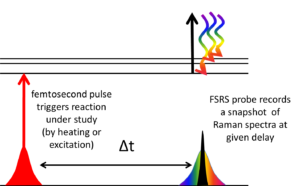
Stimulated Raman probe:
Time resolution ~100fs
Spectral resolution ~1 cm-1
Observed spectral window 30 – 4000 cm-1
Raman pulse wavelength 760-840 nm
Triggering pulse pump:
Time resolutions ~ 30fs
Spectrum ~ 50 nm
Available wavelengths 266 nm, 400 nm, 800 nm (being extended to 230-2600 nm)
Pump-probe delay 0 – 6 ns, 10 fs resolution
Optical transient absorption
Optical transient absorption spectroscopy is an experiment where changes in the sample absorbance are recorded with high time resolutions. It is a very robust technique for the characterization of excited and transient states of molecules, atoms and materials.
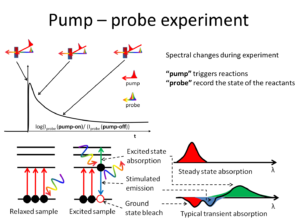
Probe pulse:
Time resolution ~20fs
Spectral resolution ~1 nm
Observed spectral window 266 – 2500 nm
Triggering pulse pump:
Time resolutions ~ 30fs
Spectrum ~ 50 nm
Available wavelengths 266 nm, 400 nm, 800 nm (being extended to 230-2600 nm)
Pump-probe delay 0 – 6 ns, 10 fs resolution
Publications:
Physical Chemistry Chemical Physics 20 (9), 6274-6286 (2018)
–IR spectroscopy (1 and 2D)
Femtosecond mid IR spectroscopy is a tool for the study of bonds of molecular and solid state systems. The vibrational spectra are recorded with fs time resolutions. That allows us to follow conformational changes such as isomerization, bond breaking, bond formation, solvent dynamics etc.…
2D IR spectroscopy is a technique for observing the presence and dynamics of cross-peaks expression of relations between individual bonds, with femtosecond resolution. Such an experiment is an IR-optical analogue of 2D NMR experiments, and likewise it produces richer data in structure.
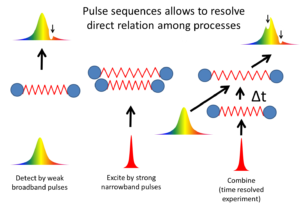
Probe pulse:
Time resolution ~100fs
Spectral resolution ~0.1 cm-1
Observed spectral window 2600 nm – 10000 nm
Triggering pulse pump:
Time resolutions ~ 30fs
Spectrum ~ 50 nm
Available wavelengths 266 nm, 400 nm, 800 nm (being extended to 230-2600 nm)
Pump-probe delay 0 – 6 ns, 10 fs resolution
-Pulse shaping and coherent control
Pulse shaping is a technique that allows to model spectral and temporal profile of the pulse. This has versatile applications in fields such as multidimensional spectroscopy, coherent control, and spatial and temporal signal encoding etc.
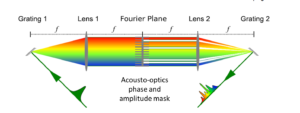
Shaping pulse properties:
Time resolution ~5fs
Spectral resolution Tunable down to ~0.1 cm-1
Available spectra window 266 nm – 2600 nm
Maximal “pulse shaping generated delay” 10ps
Pump-probe spectroscopic ellipsometry
Also located at the experimental cluster for optical spectroscopy is the station for pump-probe spectroscopic ellipsomety. This station is presented in the section for Soft X-ray material science and time-resolved ellipsometry. (link to this section)
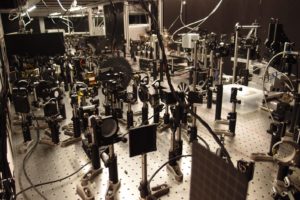
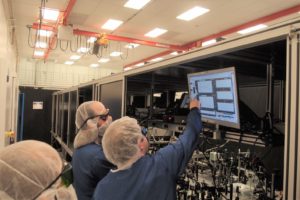
Fig: Top: Set up for fs Stimulated Raman Scattering in operation in the E1 experimental hall. Bottom: Set up for pulse shaping in operation together with a time-of-flight mass spectrometer during a user experiment where the effect of shaped pulses on catalytic reactions were investigated.
Pump beams for photoactivations
Pump beams synchronized with main photon beams will be serve for pump-probe experiments to investigate dynamical processes in matter. They will allow flexible configuration at different locations in the E1 hall, covering wavelengths from UV and visible to IR, and THz.







